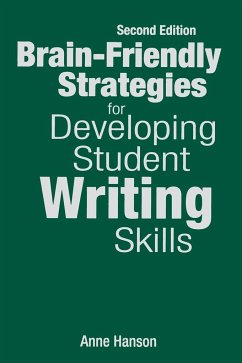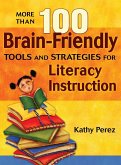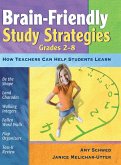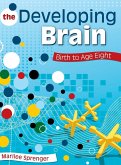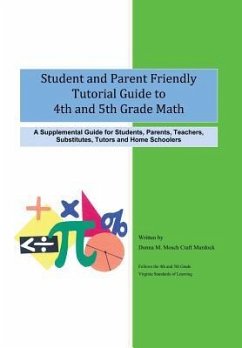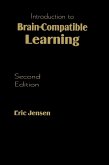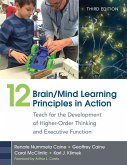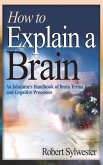Anne Hanson
Brain-Friendly Strategies for Developing Student Writing Skills
Anne Hanson
Brain-Friendly Strategies for Developing Student Writing Skills
- Gebundenes Buch
- Merkliste
- Auf die Merkliste
- Bewerten Bewerten
- Teilen
- Produkt teilen
- Produkterinnerung
- Produkterinnerung
Aligned with core principles of effective instruction, this resource provides brain-compatible strategies, reflection questions, and cross-curricular writing activities to boost students' writing and achievement.
Andere Kunden interessierten sich auch für
![More Than 100 Brain-Friendly Tools and Strategies for Literacy Instruction More Than 100 Brain-Friendly Tools and Strategies for Literacy Instruction]() Kathy PerezMore Than 100 Brain-Friendly Tools and Strategies for Literacy Instruction81,99 €
Kathy PerezMore Than 100 Brain-Friendly Tools and Strategies for Literacy Instruction81,99 €![Brain-Friendly Study Strategies, Grades 2-8 Brain-Friendly Study Strategies, Grades 2-8]() Amy SchwedBrain-Friendly Study Strategies, Grades 2-896,99 €
Amy SchwedBrain-Friendly Study Strategies, Grades 2-896,99 €![The Developing Brain The Developing Brain]() Marilee SprengerThe Developing Brain81,99 €
Marilee SprengerThe Developing Brain81,99 €![Student and Parent Friendly Tutorial Guide to 4th and 5th Grade Math Student and Parent Friendly Tutorial Guide to 4th and 5th Grade Math]() Donna M. Mosch Craft MurdockStudent and Parent Friendly Tutorial Guide to 4th and 5th Grade Math35,99 €
Donna M. Mosch Craft MurdockStudent and Parent Friendly Tutorial Guide to 4th and 5th Grade Math35,99 €![Introduction to Brain-Compatible Learning Introduction to Brain-Compatible Learning]() Eric JensenIntroduction to Brain-Compatible Learning75,99 €
Eric JensenIntroduction to Brain-Compatible Learning75,99 €![12 Brain/Mind Learning Principles in Action 12 Brain/Mind Learning Principles in Action]() Renate Nummela Caine12 Brain/Mind Learning Principles in Action45,99 €
Renate Nummela Caine12 Brain/Mind Learning Principles in Action45,99 €![How to Explain a Brain How to Explain a Brain]() Robert SylwesterHow to Explain a Brain82,99 €
Robert SylwesterHow to Explain a Brain82,99 €-
-
-
Aligned with core principles of effective instruction, this resource provides brain-compatible strategies, reflection questions, and cross-curricular writing activities to boost students' writing and achievement.
Hinweis: Dieser Artikel kann nur an eine deutsche Lieferadresse ausgeliefert werden.
Hinweis: Dieser Artikel kann nur an eine deutsche Lieferadresse ausgeliefert werden.
Produktdetails
- Produktdetails
- Verlag: Corwin
- 2. Auflage
- Seitenzahl: 202
- Erscheinungstermin: 23. Oktober 2008
- Englisch
- Abmessung: 260mm x 183mm x 16mm
- Gewicht: 585g
- ISBN-13: 9781412963497
- ISBN-10: 1412963494
- Artikelnr.: 25052110
- Herstellerkennzeichnung
- Produktsicherheitsverantwortliche/r
- Europaallee 1
- 36244 Bad Hersfeld
- gpsr@libri.de
- Verlag: Corwin
- 2. Auflage
- Seitenzahl: 202
- Erscheinungstermin: 23. Oktober 2008
- Englisch
- Abmessung: 260mm x 183mm x 16mm
- Gewicht: 585g
- ISBN-13: 9781412963497
- ISBN-10: 1412963494
- Artikelnr.: 25052110
- Herstellerkennzeichnung
- Produktsicherheitsverantwortliche/r
- Europaallee 1
- 36244 Bad Hersfeld
- gpsr@libri.de
Anne Hanson is a doctor of educational leadership whose research study dealt with the psychological syndrome of burnout in the No Child Left Behind's high-stakes testing workplace. A National Board-certified language arts teacher with 20 years of classroom experience, Hanson is a peer evaluator, recognized staff developer, and writing coach for teachers and students. Hanson's awards and recognitions include Arizona Teacher of the Year finalist, Scottsdale Middle School Teacher of the Year, Japan Fulbright Memorial Fund scholar, New York Council for the Humanities scholar, and Arizona State University Martin Luther King, Jr. Spirit Award. Her passion for teacher and student advocacy has guided her to serve as a teacher advocate and grievance representative for more than fifteen years. Advocacy has also influenced the design of her workshops, which are as diverse as her audiences, who range from administrators and teachers to parents and students. Topics include teacher and student burnout, high-stakes testing, issues facing today's students, and writing workshops for teachers and students of all ages.
Acknowledgments
About the Author
Preface
1. Introducing the Brain-Compatible Framework for Student Achievement
Four Brain-Compatible Classroom Principles
Five Core Propositions of Accomplished Teaching
Six Features of Effective Instruction
The Brain-Compatible Framework for Student Achievement
A Brain Journey
Celebrating the Learning Brain
21st-Century Brain-Compatible Teachers
21st-Century High-Stakes-Tested Students
Can You Hear Me Now?
Questions for Reflection
2. Making Connections Across Instruction, Curriculum, and Life
Characteristics of Feature One
Reflecting on the Brain-Compatible Framework and Feature One
The Brain-Compatible Framework With Feature One in Action
Learning About Our Students
Brain Surveys
Writing Connections
Writing: Pleasure or Pain?
Seven Stages of Brain-Friendly Writing Instruction
Verbs Are Your Friends: Describing Verbs
How, Why, and What Verbs
Questions for Reflection
3. Teaching Skills in Multiple Lesson Types
Characteristics of Feature Two
Separate, Simulated, and Integrated Instruction
Reflecting on the Brain-Compatible Framework and Feature Two
The Brain-Compatible Framework With Feature Two in Action
Questions for Reflection
4. Integrating Test Preparation Into Instruction
Characteristics of Feature Three?s Successful Teachers
Reflecting on the Brain-Compatible Framework and Feature Three
The Brain-Compatible Framework With Feature Three in Action
Test Savvy
Hero Quest
Questions for Reflection
5. Teaching Students Strategies for Doing the Work
Characteristics of Feature Four
Reflecting on the Brain-Compatible Framework and Feature Four
The Brain-Compatible Framework With Feature Four in Action
The Clue to Exact Writing
Setting the Stage for Authentic Assessment and Learning
Questions for Reflection
6. Expecting Generative Thinking
Characteristics of Feature Five
Reflecting on the Brain-Compatible Framework and Feature Five
The Brain-Compatible Framework and Feature Five in Action
Generative Thinking in Elementary School
Generative Thinking in Middle School
Generative Thinking in High School
Writing and Generative Thinking
Questions for Reflection
7. Fostering Cognitive Collaboration
Characteristics of Feature Six
Reflecting on the Brain-Compatible Framework and Feature Six
The Brain-Compatible Framework and Feature Six in Action
Collaboration and Seating Arrangements
Cognitive Collaboration Beyond the Classroom: Community Writing Partners
Celebrate the Results
Authors¿ Day
Questions for Reflection
8. Envisioning Every Child as a Lifelong Learner
References
Index
About the Author
Preface
1. Introducing the Brain-Compatible Framework for Student Achievement
Four Brain-Compatible Classroom Principles
Five Core Propositions of Accomplished Teaching
Six Features of Effective Instruction
The Brain-Compatible Framework for Student Achievement
A Brain Journey
Celebrating the Learning Brain
21st-Century Brain-Compatible Teachers
21st-Century High-Stakes-Tested Students
Can You Hear Me Now?
Questions for Reflection
2. Making Connections Across Instruction, Curriculum, and Life
Characteristics of Feature One
Reflecting on the Brain-Compatible Framework and Feature One
The Brain-Compatible Framework With Feature One in Action
Learning About Our Students
Brain Surveys
Writing Connections
Writing: Pleasure or Pain?
Seven Stages of Brain-Friendly Writing Instruction
Verbs Are Your Friends: Describing Verbs
How, Why, and What Verbs
Questions for Reflection
3. Teaching Skills in Multiple Lesson Types
Characteristics of Feature Two
Separate, Simulated, and Integrated Instruction
Reflecting on the Brain-Compatible Framework and Feature Two
The Brain-Compatible Framework With Feature Two in Action
Questions for Reflection
4. Integrating Test Preparation Into Instruction
Characteristics of Feature Three?s Successful Teachers
Reflecting on the Brain-Compatible Framework and Feature Three
The Brain-Compatible Framework With Feature Three in Action
Test Savvy
Hero Quest
Questions for Reflection
5. Teaching Students Strategies for Doing the Work
Characteristics of Feature Four
Reflecting on the Brain-Compatible Framework and Feature Four
The Brain-Compatible Framework With Feature Four in Action
The Clue to Exact Writing
Setting the Stage for Authentic Assessment and Learning
Questions for Reflection
6. Expecting Generative Thinking
Characteristics of Feature Five
Reflecting on the Brain-Compatible Framework and Feature Five
The Brain-Compatible Framework and Feature Five in Action
Generative Thinking in Elementary School
Generative Thinking in Middle School
Generative Thinking in High School
Writing and Generative Thinking
Questions for Reflection
7. Fostering Cognitive Collaboration
Characteristics of Feature Six
Reflecting on the Brain-Compatible Framework and Feature Six
The Brain-Compatible Framework and Feature Six in Action
Collaboration and Seating Arrangements
Cognitive Collaboration Beyond the Classroom: Community Writing Partners
Celebrate the Results
Authors¿ Day
Questions for Reflection
8. Envisioning Every Child as a Lifelong Learner
References
Index
Acknowledgments
About the Author
Preface
1. Introducing the Brain-Compatible Framework for Student Achievement
Four Brain-Compatible Classroom Principles
Five Core Propositions of Accomplished Teaching
Six Features of Effective Instruction
The Brain-Compatible Framework for Student Achievement
A Brain Journey
Celebrating the Learning Brain
21st-Century Brain-Compatible Teachers
21st-Century High-Stakes-Tested Students
Can You Hear Me Now?
Questions for Reflection
2. Making Connections Across Instruction, Curriculum, and Life
Characteristics of Feature One
Reflecting on the Brain-Compatible Framework and Feature One
The Brain-Compatible Framework With Feature One in Action
Learning About Our Students
Brain Surveys
Writing Connections
Writing: Pleasure or Pain?
Seven Stages of Brain-Friendly Writing Instruction
Verbs Are Your Friends: Describing Verbs
How, Why, and What Verbs
Questions for Reflection
3. Teaching Skills in Multiple Lesson Types
Characteristics of Feature Two
Separate, Simulated, and Integrated Instruction
Reflecting on the Brain-Compatible Framework and Feature Two
The Brain-Compatible Framework With Feature Two in Action
Questions for Reflection
4. Integrating Test Preparation Into Instruction
Characteristics of Feature Three?s Successful Teachers
Reflecting on the Brain-Compatible Framework and Feature Three
The Brain-Compatible Framework With Feature Three in Action
Test Savvy
Hero Quest
Questions for Reflection
5. Teaching Students Strategies for Doing the Work
Characteristics of Feature Four
Reflecting on the Brain-Compatible Framework and Feature Four
The Brain-Compatible Framework With Feature Four in Action
The Clue to Exact Writing
Setting the Stage for Authentic Assessment and Learning
Questions for Reflection
6. Expecting Generative Thinking
Characteristics of Feature Five
Reflecting on the Brain-Compatible Framework and Feature Five
The Brain-Compatible Framework and Feature Five in Action
Generative Thinking in Elementary School
Generative Thinking in Middle School
Generative Thinking in High School
Writing and Generative Thinking
Questions for Reflection
7. Fostering Cognitive Collaboration
Characteristics of Feature Six
Reflecting on the Brain-Compatible Framework and Feature Six
The Brain-Compatible Framework and Feature Six in Action
Collaboration and Seating Arrangements
Cognitive Collaboration Beyond the Classroom: Community Writing Partners
Celebrate the Results
Authors¿ Day
Questions for Reflection
8. Envisioning Every Child as a Lifelong Learner
References
Index
About the Author
Preface
1. Introducing the Brain-Compatible Framework for Student Achievement
Four Brain-Compatible Classroom Principles
Five Core Propositions of Accomplished Teaching
Six Features of Effective Instruction
The Brain-Compatible Framework for Student Achievement
A Brain Journey
Celebrating the Learning Brain
21st-Century Brain-Compatible Teachers
21st-Century High-Stakes-Tested Students
Can You Hear Me Now?
Questions for Reflection
2. Making Connections Across Instruction, Curriculum, and Life
Characteristics of Feature One
Reflecting on the Brain-Compatible Framework and Feature One
The Brain-Compatible Framework With Feature One in Action
Learning About Our Students
Brain Surveys
Writing Connections
Writing: Pleasure or Pain?
Seven Stages of Brain-Friendly Writing Instruction
Verbs Are Your Friends: Describing Verbs
How, Why, and What Verbs
Questions for Reflection
3. Teaching Skills in Multiple Lesson Types
Characteristics of Feature Two
Separate, Simulated, and Integrated Instruction
Reflecting on the Brain-Compatible Framework and Feature Two
The Brain-Compatible Framework With Feature Two in Action
Questions for Reflection
4. Integrating Test Preparation Into Instruction
Characteristics of Feature Three?s Successful Teachers
Reflecting on the Brain-Compatible Framework and Feature Three
The Brain-Compatible Framework With Feature Three in Action
Test Savvy
Hero Quest
Questions for Reflection
5. Teaching Students Strategies for Doing the Work
Characteristics of Feature Four
Reflecting on the Brain-Compatible Framework and Feature Four
The Brain-Compatible Framework With Feature Four in Action
The Clue to Exact Writing
Setting the Stage for Authentic Assessment and Learning
Questions for Reflection
6. Expecting Generative Thinking
Characteristics of Feature Five
Reflecting on the Brain-Compatible Framework and Feature Five
The Brain-Compatible Framework and Feature Five in Action
Generative Thinking in Elementary School
Generative Thinking in Middle School
Generative Thinking in High School
Writing and Generative Thinking
Questions for Reflection
7. Fostering Cognitive Collaboration
Characteristics of Feature Six
Reflecting on the Brain-Compatible Framework and Feature Six
The Brain-Compatible Framework and Feature Six in Action
Collaboration and Seating Arrangements
Cognitive Collaboration Beyond the Classroom: Community Writing Partners
Celebrate the Results
Authors¿ Day
Questions for Reflection
8. Envisioning Every Child as a Lifelong Learner
References
Index

